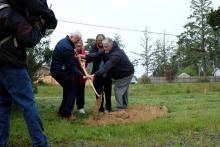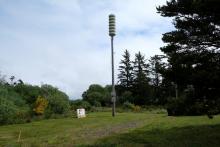FEMA Region 10 Earthquake Program Manager Amanda Siok shares how the people of the Shoalwater Bay Tribe are proactively taking steps to protect their community from an earthquake and tsunami.
The Washington and Oregon coastlines sit on the edge of two plate tectonics. The intersection of these plates is called the Cascadia Subduction Zone, where the oceanic plate is being pushed underneath the continental plate. This action, known as subducting, occurs at the same rate your fingernails grow. This process fuels the 13 active volcanoes in the Cascade Range, including Mount Rainier and Mount St. Helens. Roughly every 300-500 years the fault slips creating a massive earthquake and tsunami. The last Cascadia earthquake happened 321 years ago, in 1700, impacting tribes living along the Pacific Coast including the Shoalwater Bay Tribe.
The tribe recounts stories from the 1700 Cascadia earthquake and tsunami in their hazard mitigation plan. Stories of this massive event have been passed down through generations explaining that the earthquake and tsunami triggered landslides that also destroyed some villages. Many native village sites were abandoned or relocated after this event. It also describes natives finding trash among treetops and canoes in the woods.
It wasn’t until 1995 that scientists really began to understand the tectonics of the Cascadia Subduction Zone, realizing the 1700 event is cyclical and will happen again.
In 2004, the Indian Ocean earthquake and tsunami killed some 220,000 people and elevated the importance of understanding tsunami vulnerabilities to coastal towns. FEMA and NOAA studied how to build structures capable of withstanding earthquake and tsunami forces and published guidance in P-646 . Then, Washington Emergency Management Division created Project Safe Haven to guide earthquake and tsunami vulnerability assessments, evacuation planning, and vertical evacuation needs assessments.
The Shoalwater Bay Tribe used the Safe Haven process and determined that in a Cascadia event, time doesn’t allow for safe evacuation to reach high ground before a tsunami makes landfall. The tribe decided they needed a vertical evacuation structure to provide safety for their people and immediately identified potential locations and designs.
The tribe budgeted for the design and construction of a tower that would be built to withstand both earthquake shaking and tsunami waves. They applied for a FEMA Pre-Disaster Mitigation Grant and received $2.8 million, using tribal funds for the match, to build the first federally funded tsunami vertical evacuation structure. The tower is intended to provide temporary refuge above tsunami waves for tribal members, as well as residents of the neighboring town.

Engineering drawings of FEMA-funded Tsunami Vertical Evacuation Tower for the Shoalwater Bay Tribe and Tokeland. Photo Credit: Degenkolb Engineers.
On May 17, 2021 the tribe celebrated the funding and start of construction of this project with a groundbreaking ceremony. Construction of the tower will be complete in Winter 2021-2022. This is the first tsunami evacuation tower like this in the country and a great step towards mitigation risk for this coastal tribe and community.

Groundbreaking with Washington Emergency Management Division Director Robert Ezelle, Shoalwater Bay’s First Emergency Manager Lee Shipman, Tribal Council Chairperson Charlene Nelson and Acting FEMA Region 10 Administrator Vince Maykovich.

Tsunami warning siren at the future site of the tsunami tower.
Learn more about the Shoalwater Bay Tribe’s Hazard Mitigation Plan, their traditional stories, and why a Mitigation Plan would have saved Jurassic Park in an upcoming FEMA podcast.


